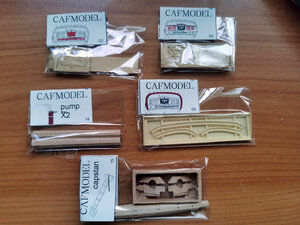Were the CAD drawings of the construction components done by you or part of the kit? They really clarify the relationship between the parts as the build progresses. Also providing a computer driven milling process for some parts needed. PT-2So will I, placed the order. Looking forward for the first feedback from people who receive the kit and start the build
You are using an out of date browser. It may not display this or other websites correctly.
You should upgrade or use an alternative browser.
You should upgrade or use an alternative browser.
Caf Model - New Kit 1/48 Le Coureur 1776
What glue did you use on the stacked frames?
If you asked me @Chello : I only use PVA (normal, express, waterproof) when building with wood ... CA only where really neccessary, for small metal-parts or so ...
If you asked Tom (CAF): I'd be interested in recommandations too
Last edited:
- Joined
- Mar 19, 2020
- Messages
- 206
- Points
- 213

Contacted Tom and I will share his reply.I you asked me @Chello : I only use PVA (normal, express, waterproof) when building with wood ... CA only where really neccessary, for small metal-parts or so ...
If you asked Tom (CAF): I'd be interested in recommandations too
- Joined
- Mar 19, 2020
- Messages
- 206
- Points
- 213

I have got the reply from Tom just need to figure out how to forward it to youIf you asked me @Chello : I only use PVA (normal, express, waterproof) when building with wood ... CA only where really neccessary, for small metal-parts or so ...
If you asked Tom (CAF): I'd be interested in recommandations too
Please explain. Where does the price of $256 appear at the beginning of this thread? As I understand it, the price for the model is $342 US, and I do not see a reduction anywhere.
Please explain. Where does the price of $256 appear at the beginning of this thread? As I understand it, the price for the model is $342 US, and I do not see a reduction anywhere.
I am going to the site right now..... But as I remember, the special pricing ended on June 30th. It was Pre-order pricing IIRC.....
Thanks Hobbit99,
Looks like I missed something.
Looks like I missed something.
Zibby,
I am waiting for the special edition of this model in boxwood.
I am waiting for the special edition of this model in boxwood.
Wow.
Sounds interesting. When and for how much?
Sounds interesting. When and for how much?
The price of $256.00 (plus shipping) was an introductory price. When Tom (CAF) announced the kit design, he offered this price to all who will buy the kit as pre-order, until June 31. Now the site reflects the full price of $342.00 US (plus shipping)Please explain. Where does the price of $256 appear at the beginning of this thread? As I understand it, the price for the model is $342 US, and I do not see a reduction anywhere.
Hope this will help.
The boxwood version is planned for a later date.
Thank you all for comprehensive information.
Hello ,I have bought some boxwood, but the wood is still wet and can't be cut。I think it needs to be kept until the end of this year。
I'm also looking for dry boxwood。
I'm also looking for dry boxwood。
- Joined
- Mar 19, 2020
- Messages
- 206
- Points
- 213

Hi Tom, Not wanting to start another bout of channel fever, but are you still planning to ship the first kits out mid August?Hello ,I have bought some boxwood, but the wood is still wet and can't be cut。I think it needs to be kept until the end of this year。
I'm also looking for dry boxwood。
Hi Marcel ,We are trying to catch up with the schedule and hope to deliver the goods in the middle of August. Now, in addition to waiting for the delivery of casting parts, there are three final carving parts in production. It'll be done this week。
- Joined
- Mar 19, 2020
- Messages
- 206
- Points
- 213

Good news. Thank you TomHi Marcel ,We are trying to catch up with the schedule and hope to deliver the goods in the middle of August. Now, in addition to waiting for the delivery of casting parts, there are three final carving parts in production. It'll be done this week。
The Le Coureur is chasing the HMS AlertFirst draft, the composition needs to be adjusted again, and then you can draw an oil painting
View attachment 172501
sorry to highjack your topic, but I think some members would be interested in this history of the vessel.....
I guess this painting is based somehow on the well known painting Combat de la Belle Poule et de l'Aréthusa en 1778 (Fight of Belle Poule and Arethusa) from Auguste-Louis de Rossel de Cercy, painted 1789
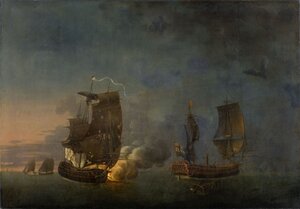
Excerpt:
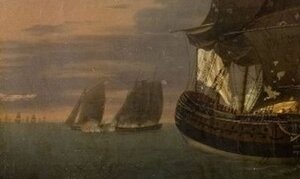
The British cutter Alert, Lieut. William George Fairfax, attacked the French lugger Coureur. The Alert carried eighty men, twelve 6's, and as many swivels: the Coureur had fifty men, two 3's, eight 2's, and six swivels; she was commanded by Enseigne de Rosily. She was ordered to go to the British Admiral; refused; and was at once fired upon. The two fought at pistol-shot range for nearly an hour and a half, until the Coureur struck. She hit the Alert several times on the water-line and cut up her rigging.
from Threedecks:
Alert vs Coureur, 17th June 1778
Description and participants : Alert vs Coureur, 17th June 1778
threedecks.org
Lugger Le Coureur:
French lugger 'Le Coureur' (1776)
French lugger 'Le Coureur' (1776). Dates of service, name changes, previous and next incarnations, dimensions, armament, commanders, officers and crewmen, actions, battles, sources
threedecks.org
British cutter 'Alert' (1777)
British cutter 'Alert' (1777). Dates of service, name changes, previous and next incarnations, dimensions, armament, commanders, officers and crewmen, actions, battles, sources
threedecks.org
From wikipedia the complete description of the main fight:
Action of 17 June 1778
The Action of 17 June 1778 also known as the Fight of Belle Poule and Arethusa was a minor naval action that took place off the coast of France between British and French frigates. The action was widely celebrated by both France and Great Britain and was the first between the two naval forces during the American Revolutionary War before a formal declaration of war was even announced.
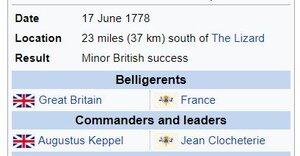
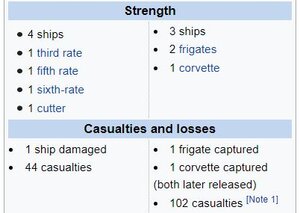
Background
On 13 June 1778, Admiral Augustus Keppel, with twenty-one ships of the line and three frigates, was dispatched by the Admiralty to keep watch over the French fleet at Brest; Keppel was to prevent a junction of the Brest and Toulon fleets, more by persuasion if he could since both nations were not at war. The French 26-gun frigate, Belle Poule was on a reconnaissance along with the 26-gun frigate Licorne, the corvette Hirondelle, and the cutter Coureur, when on 17 June she encountered a large British squadron that included HMS Arethusa at a point 23 miles (37 km) south of The Lizard.
Admiral Keppel, commanding the British fleet, ordered that the French ships be pursued and returned to his flagship by any means since he did not want the French ships to see the British strength.
Action
Licorne did so, after being overhauled by two British ships HMS Milford, mounting 28 guns, and HMS America, of 64 guns. Licorne subsequently tried to escape during the night after having meditated on affairs, but surrendered after a brief combat with America, a vessel double her size.
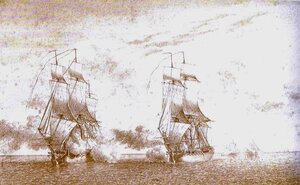
Beginning of the action
Meanwhile, Arethusa and the cutter HMS Alert caught up to Belle Poule, accompanied by the French cutter Le Courier. The captain of Belle Poule refused the order to sail back to the British fleet. The British fired a warning shot across his ship's bow, to which he responded with a full broadside. Thus a furious, two-hour battle between the two ships with Arethusa. Belle Poule was eager to escape and soon began to inflict serious damage upon Arethusa, which ended up with her topmasts hanging over the side and canvas torn. Soon after Arethusa lay shattered and then lost her main mast.
Soon the wind fell and with it the shot-torn loftier sails of Belle Poule. However, they held enough wind to drift her out of the reach of Arethusa's fire. Both ships were close under the French cliffs and Belle Poule struggled into a tiny cove in the rocks. Nothing remained for Arethusa but to cut away her wreckage, hoist what sail she could, and drag herself back under jury-masts to the British fleet.
Meanwhile, Coureur was overtaken by the British cutter Alert, and after some resistance finally cooperated with being taken to Keppel's flagship. Hirondelle escaped the engagement entirely.
Aftermath
Arethusa suffered 44 casualties from her 198-man crew, but the masts and rigging had been so severely damaged that the ship had to be towed by newly arrived British ships. As other ships from Keppel's fleet approached, Belle Poule withdrew toward the French coast having lost 30 killed and 72 wounded, among them her captain, Lieutenant Jean Isaac Chadeau de la Clocheterie.
This battle was the first between British and French naval forces during the Anglo-French War[4] and took place around three weeks before the formal declaration of war by France. Admiral Keppel himself was surprised by the reaction of the French captains as he only intended to speak with them, and then release their ships.
The battle was widely celebrated in France as a victory; ladies of the high society invented the hairstyle "Belle Poule", with a ship on the top of the head.
With the capture of Licorne and Hirondelle it was also viewed as a victory in Britain and became the subject of a traditional Sea shanty, The Saucy Arethusa.
Arethusa is also the subject of a song on the Decemberists' album Her Majesty the Decemberists.

Action of 17 June 1778 - Wikipedia
- Joined
- Mar 19, 2020
- Messages
- 206
- Points
- 213

I think Uwe, that story justifies my decision to order them both.The Le Coureur is chasing the HMS Alert
sorry to highjack your topic, but I think some members would be interested in this history of the vessel.....
I guess this painting is based somehow on the well known painting Combat de la Belle Poule et de l'Aréthusa en 1778 (Fight of Belle Poule and Arethusa) from Auguste-Louis de Rossel de Cercy, painted 1789
View attachment 172522
Excerpt:
View attachment 172523
The British cutter Alert, Lieut. William George Fairfax, attacked the French lugger Coureur. The Alert carried eighty men, twelve 6's, and as many swivels: the Coureur had fifty men, two 3's, eight 2's, and six swivels; she was commanded by Enseigne de Rosily. She was ordered to go to the British Admiral; refused; and was at once fired upon. The two fought at pistol-shot range for nearly an hour and a half, until the Coureur struck. She hit the Alert several times on the water-line and cut up her rigging.
from Threedecks:
Alert vs Coureur, 17th June 1778
Description and participants : Alert vs Coureur, 17th June 1778threedecks.org
Lugger Le Coureur:
Cutter HMS Alert:French lugger 'Le Coureur' (1776)
French lugger 'Le Coureur' (1776). Dates of service, name changes, previous and next incarnations, dimensions, armament, commanders, officers and crewmen, actions, battles, sourcesthreedecks.org
British cutter 'Alert' (1777)
British cutter 'Alert' (1777). Dates of service, name changes, previous and next incarnations, dimensions, armament, commanders, officers and crewmen, actions, battles, sourcesthreedecks.org
From wikipedia the complete description of the main fight:
Action of 17 June 1778
The Action of 17 June 1778 also known as the Fight of Belle Poule and Arethusa was a minor naval action that took place off the coast of France between British and French frigates. The action was widely celebrated by both France and Great Britain and was the first between the two naval forces during the American Revolutionary War before a formal declaration of war was even announced.
View attachment 172527 View attachment 172528
Background
On 13 June 1778, Admiral Augustus Keppel, with twenty-one ships of the line and three frigates, was dispatched by the Admiralty to keep watch over the French fleet at Brest; Keppel was to prevent a junction of the Brest and Toulon fleets, more by persuasion if he could since both nations were not at war. The French 26-gun frigate, Belle Poule was on a reconnaissance along with the 26-gun frigate Licorne, the corvette Hirondelle, and the cutter Coureur, when on 17 June she encountered a large British squadron that included HMS Arethusa at a point 23 miles (37 km) south of The Lizard.
Admiral Keppel, commanding the British fleet, ordered that the French ships be pursued and returned to his flagship by any means since he did not want the French ships to see the British strength.
Action
Licorne did so, after being overhauled by two British ships HMS Milford, mounting 28 guns, and HMS America, of 64 guns. Licorne subsequently tried to escape during the night after having meditated on affairs, but surrendered after a brief combat with America, a vessel double her size.
View attachment 172531
Beginning of the action
Meanwhile, Arethusa and the cutter HMS Alert caught up to Belle Poule, accompanied by the French cutter Le Courier. The captain of Belle Poule refused the order to sail back to the British fleet. The British fired a warning shot across his ship's bow, to which he responded with a full broadside. Thus a furious, two-hour battle between the two ships with Arethusa. Belle Poule was eager to escape and soon began to inflict serious damage upon Arethusa, which ended up with her topmasts hanging over the side and canvas torn. Soon after Arethusa lay shattered and then lost her main mast.
Soon the wind fell and with it the shot-torn loftier sails of Belle Poule. However, they held enough wind to drift her out of the reach of Arethusa's fire. Both ships were close under the French cliffs and Belle Poule struggled into a tiny cove in the rocks. Nothing remained for Arethusa but to cut away her wreckage, hoist what sail she could, and drag herself back under jury-masts to the British fleet.
Meanwhile, Coureur was overtaken by the British cutter Alert, and after some resistance finally cooperated with being taken to Keppel's flagship. Hirondelle escaped the engagement entirely.
Aftermath
Arethusa suffered 44 casualties from her 198-man crew, but the masts and rigging had been so severely damaged that the ship had to be towed by newly arrived British ships. As other ships from Keppel's fleet approached, Belle Poule withdrew toward the French coast having lost 30 killed and 72 wounded, among them her captain, Lieutenant Jean Isaac Chadeau de la Clocheterie.
This battle was the first between British and French naval forces during the Anglo-French War[4] and took place around three weeks before the formal declaration of war by France. Admiral Keppel himself was surprised by the reaction of the French captains as he only intended to speak with them, and then release their ships.
The battle was widely celebrated in France as a victory; ladies of the high society invented the hairstyle "Belle Poule", with a ship on the top of the head.
With the capture of Licorne and Hirondelle it was also viewed as a victory in Britain and became the subject of a traditional Sea shanty, The Saucy Arethusa.
Arethusa is also the subject of a song on the Decemberists' album Her Majesty the Decemberists.

Action of 17 June 1778 - Wikipedia
en.wikipedia.org







